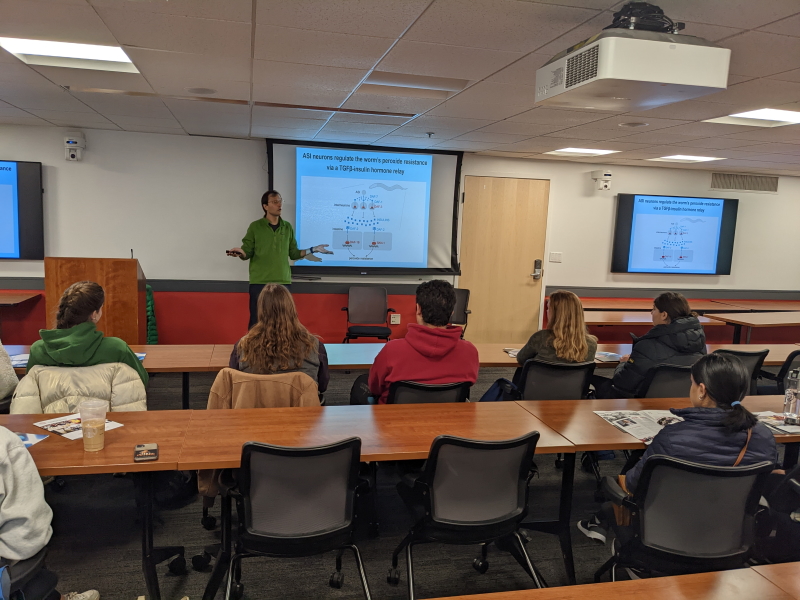Last Friday, December 2, 2022 the Center for STEM Education at Northeastern University, in collaboration with the College of Engineering/Admissions, hosted the Fall edition of our Building Bridges event. 93 students from 36 different schools in 3 states came to learn all about engineering. Students picked from 14 different sessions, wherein students learned about various engineering topics through hands-on activities and presentations (see below for what was offered).
The day started with a welcome from Center for STEM Education Director, Claire Duggan, followed by an introduction to Northeastern’s College of Engineering by Asst. Dean Rachelle Reisberg. Students then attended two sessions they selected based on their engineering interests. During lunch, Northeastern’s
student-led product development studio, Generate, met with the students and discussed their organization and did a product development/pitch activity with the students. The day concluded with an engineering campus tour led by Northeastern students, who also answered any remaining questions.
Thank you to all faculty, staff members, volunteers, and student presenters for your help today and making this day possible!
Sessions:
- Soft Materials and Machines (MIE) by Sabrina Marnoto [Professor Sara Hashmi’s lab]
- Building Bridges Board Game (MIE) by Professor Michael Allshouse‘s MIE Capstone Group
Meet a Mechanical Engineering Capstone team that has designed an interactive bridge building board game. Compete against a partner to see whose bridge is strongest and learn about the capstone design process. - How do Worms Deal with Stress? (Biology) by Professor Javier Apfeld
Learn how C. elegans worms can be used to study how signals from the brain control aging and resilience to stress - Soft Materials and Machines (MIE) by Professor Ruobing Bai
Explore new research in soft materials and machines and visit Northeastern’s materials lab. - Polymeric Hydrogels to Improve Life (BioE) by Professor Sidi Bencherif
Learn what polymers are and how they could be used for biomedical applications; ex: as a drug delivery device for the controlled release of therapeutics. - Pollutant Source Identification using Chromatography (CEE) by Professor Loretta Fernandez
Students will use thin-layer chromatography to identify the components of a mixture of groundwater contaminants. By comparing the chromatograms to those of potential source materials, students can hypothesize how the ground water became contaminated. - Engineering the Next Generation of Wireless Communication Networks (ECE) by Professor Josep Jornet, Stefano Basagni, and Michele Polese
A general introduction to wireless communications and the future of wireless networks. - Illusion Optics (ECE) by Professor Yongmin Liu
Build your own 3D hologram pyramid and invisibility cloak that helps you to understand the fundamentals of optical imaging - First Year Engineering (FYE) by Professor Jennifer Love
Learn more about the first year classes and final cornerstone projects required at Northeastern University. - Thermal Acoustic Imaging for Geoscience Applications (MIE) by Weite Zhang (Professor Jose Martinez Lorenzo‘s lab)
Learn about thermal acoustic imaging via the testbed in SICA-Lab and how the thermal acoustic imaging can be used for realistic geoscience applications. - Optimizing Production: Can you Build it Better? Faster? (MIE) by Professor Hande Musdal Ondemir
Explore two primary modes of production, assembly line or single production method and learn about important industrial engineering applications. - Building Cellular Skeletons (BioE) by Vasuretha Chandar (Professor Harikrishnan Parameswaran‘s lab)
Build a toy model of the cellular cytoskeleton and learn how the skeleton helps cells adapt to dynamic changes in the extracellular environment. - Traffic Jams: Why always blame human drivers? (MIE) by Professor Rifat Sipahi
Investigate the root causes of jam formations in traffic and explain how jams impact economies, environment, and our goals toward establishing a sustainable future. - Human Movements – how do we learn movement skills? (Biology) by Professor Dagmar Sternad
View and participate in several experimental stations where we record movements, including 3D motion capture, force plates, virtual environment, and recording of brain activity. - Mechanical Engineering Capstone Preview (MIE) by MIE Capstone Groups
Meet with and view the capstone projects of various mechanical engineering (ME) capstone groups and learn more about ME from NEU seniors










